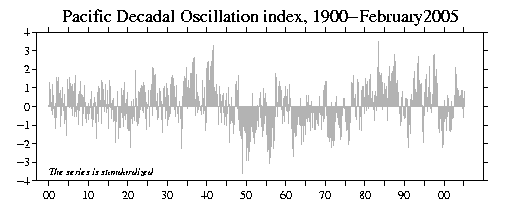JISAO data
Pacific Decadal Oscillation (PDO) Index
Analyses | Data

big GIF |
EPS |
JPEG |
PDF |
PNG |
PostScript
The PDO is defined as the leading EOF of mean November through March SST
anomalies for the Pacific Ocean to the north of 20N latitude. For
the EOF calculation, the global mean SST anomaly was first removed for
each month in order to reduce the influence of the long-term trends in
the data. The above plot
is of the amplitudes of this EOF in monthly data from 1900 - February 2005. The amplitudes have been standardized and
you will have to contact Nate Mantua (mantua@atmos.washington.edu)
to find out which years he used
to standardize the time series. Positive values indicate months of above
normal SSTs along the west coast of the North and Central America and
on the equator, and below normal SSTs in the central and western north
Pacific at about the latitude of Japan. Fluctuations in this pattern
are dominated by variability on the decadal time scale.
Nate Mantua maintains a very nice WWW page documenting the PDO.
References:
Mantua, N. J., S. R. Hare, Y. Zhang, J. M. Wallace, and R. C. Francis,
1997: A Pacific interdecadal climate oscillation with impacts on
salmon production. Bull. Amer. Meteor. Soc., 78,
1069-1079.
Zhang, Y., J. M. Wallace, and D. S. Battisti, 1997: ENSO-like
interdecadal variability: 1900-93. J. Climate, 10, 1004-1020.
Data:
The monthly values are the amplitude in each calendar
month and year of the PDO spatial pattern. The PDO spatial pattern
itself is derived from mean November through March data.
Year-month
table most up-to-date
3-column table (year, month, value) not updated regularly.
1-column table (PDO value) not updated regularly.
March 2005
Todd Mitchell ( mitchell@atmos.washington.edu
)
JISAO data

